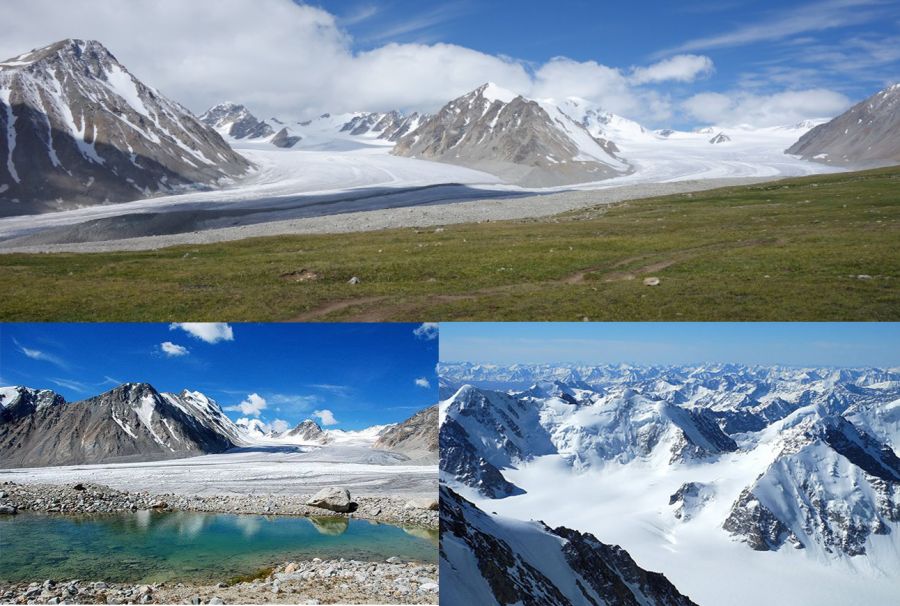Altai Tavan Bogd is a region of breathtaking natural beauty that represents the unique ecosystems of high mountain glaciers, ice-capped peaks, alpine meadows, and steppes. It is home to a variety of mammals such as argali sheep, ibex, and red deer, as well as birds including Altai snowcocks, bearded vultures, and eagles. The area is highly suitable for mountain sports and eco-tourism and was therefore declared a Strictly Protected Area by Resolution No. 43 of the State Great Khural in 1996.

The administration of the Mongol Altai Mountain Range is based in Altai city of Bayan-Ölgii province and is responsible for the protection of the Altai Tavan Bogd and Siilkhem Natural Complexes, as well as the Devel Island Nature Reserve. Altai Tavan Bogd lies along the western edge of the Mongol Altai range, stretching from north to south. Its river basins—including the Khurgan, Khoton, Dayan, Khovd, Khar Salaa, Tsagaan Salaa, Songinot, and Yolt Rivers—are surrounded by high mountains and belong to the high-mountain zone of the Mongol Altai’s mountainous region.
Tavan Bogd Mountain is one of the highest mountain ranges in Mongolia, featuring six permanently snow-capped peaks rising above 4,000 meters.
- Khüiten Peak – 4,374 m (the highest peak)
- Nairamdal Peak – 4,192 m (the tri-border point of Mongolia, Russia, and China)
- Tsagaan Suvarga Peak – 4,152 m
- Bürged Peak – 4,068 m
- Malchin Peak – 4,051 m
- Ölgii Peak – 4,050 m
The elevated terrain consists of mountains separated by valleys formed through erosion and deposition, as well as intermountain depressions. The highest point in Mongolia, Khüiten Peak, is located here, standing at 4,374 meters above sea level. The lowest point is Lake Khurgan at 1,800 meters. Major glacial lakes such as Khoton, Khurgan, and Dayan are found here, along with more than 250 smaller lakes. Approximately 96% of Mongolia’s glaciers are located in the Mongol Altai range, including the Potanin Glacier, the largest in the country, covering 24 square kilometers. The region’s soils mainly consist of mountain dark brown soils and meadow-bog soils, with rocky terrain.
More than 1,200 plant species have been recorded in this area, including 131 woody and shrub species and 889 herbaceous species. Some sparse Siberian larch forests are also present. Rare and endangered species listed in the Mongolian Red Book such as the snow leopard, Eurasian otter, Altai argali, ibex, and red deer inhabit the area. Wetlands and rivers attract a wide variety of waterfowl, while cliffs and forests provide nesting grounds for birds of prey like eagles, vultures, lammergeiers, falcons, and hawks. Rare bird species found here include the Altai snowcock, Pallas’s rosefinch, the great cormorant, whooper swan, black stork, Caspian gull, and wild geese. The rivers are rich in fish such as Mongolian grayling, Altai osman, and stone loach.
The area is also rich in cultural heritage, with numerous petroglyphs, tamgas (tribal seals), and inscriptions carved into rocks. These date back 2,500–3,000 years and are important archaeological relics. The deer stones (ancient steles) in the Altai differ from those in the Khangai Mountains in that they often depict horses instead of deer, as well as swords and celestial symbols like the sun, moon, and arrows. There are many ancient burial sites from the periods of the Hunnu, Turkic, Uyghur, and Mongol Empires, though their exact dating is still under research. For example, over 30 burials with human stone statues are found in the Mogoyt and Onkhot Valleys. Around Lake Khoton, there are fascinating tombs marked with two human-shaped stone statues. Other such tombs are located near Shar Bulag, Yolt’s Kharbain Salaa, Chikhert, Jalanash, and Songinot.
As the homeland of Kazakh and Tuvan ethnic groups, this area offers great opportunities to explore their lifestyles, customs, and survival techniques, enriching any travel itinerary. Mountain sports tourism has been especially well developed in this region.